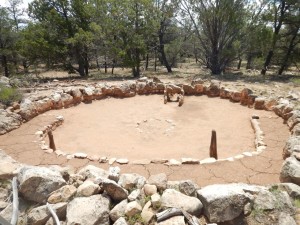July 22

There’s not really a story to tell today; it was as leisurely as yesterday was strenuous. The last time I visited Grand Canyon National Park, my longest hike was 8 (level) miles along the Rim Trail, between Hermit’s Rest and Grand Canyon Village, seeing everything along the way. That’s to the west of the village; I never went back along the 30 miles of park road to the east. When I arrived here this time, I also drove past those overlooks on the way to my hotel. Since my plan was to do different things this time, I headed east to the Watchtower area and then worked my way back, seeing all the sights along that road.
I notice something going over the pictures I took: once again the camera doesn’t capture all the human eye sees. Each different scenic spot has something different to offer, but one photograph of the canyon looks much like another, barring differences in lighting or interesting clouds or something. The photos are all beautiful— but also the same as each other. You just have to be there to see why it’s worth stopping at each different point. So I’ll post only a key few of the pictures I took.
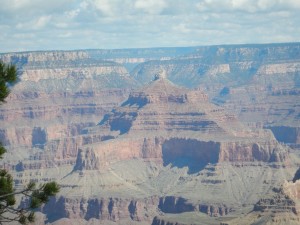 |
Erosion in the Grand Canyon has carved a lot of this kind of shape, called “temples” by early geologists studying and mapping it, because they reminded them of the shape of temples in India and Asia. |
| This bend in the Colorado river near the mouth of the Canyon produces an area of flat and fertile land around it. Native Americans had a village here, and terraced farms along the banks, for centuries. Probably the Ancestral Puebloans of Mesa Verde fame, whose ruins are all over the Southwest. They vanished long before European settlers arrived in the area, but modern the Hopi and Taos Pueblo tribes both claim descent from them, and Hopi legends still recall the Grand Canyon as their ancestral home. Archaeologists did not discover evidence of their settlement here until 1964. Today excavations at the site continue. |
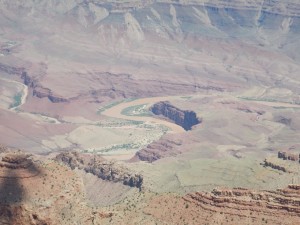 |
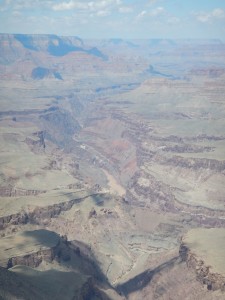 |
The Colorado River has dug its way so deep into the inner canyon that across much of the national park, it can’t be seen from the rim. Some overlooks give a glimpse of a bit of it. But here near the start of the canyon, the river makes a sharp bend and the overlook at Lipan point gives you a view directly along the deepest part of the canyon. |
The view from Lipan is a view of almost the entire geological history of the North American continent. The bottom layer of the canyon is “Basement rock,” the original material from which the continent was formed, around 2 billion years old. Some of the earliest signs of life on Earth are found just above that, stromatolites formed by cyanobacteria in shallow seas.
The area of the Grandy Canyon was (like much of the southwest) an inland sea, basically an extension of the present Gulf of Mexico, on and off over geological time. Layers of sediments on top of sediments continue until the top of the canyon is “only” around 70 million years old.
Up on top of the canyon, ruins of an Ancestral Puebloan settlement dated to 1185 AD are found at the Tusayan site. Archaeologists used to call this vanished tribe the “Anasazi,” but that can’t be what they called themselves— it’s a Navajo word for “Ancestral enemies.” There wasn’t peace between tribes— the famed cliff dwellings this vanished society build were for defense against hostile neighbors.
This settlement, with living quarters (left) and a ceremonial kiva (right) never housed more than around 30 people, perhaps a single clan or extended family.
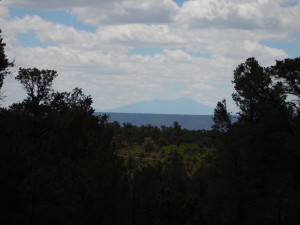
The San Francisco Mountains, visible from the ruin, are extinct volcanoes that were active as recently as 1000 years ago— when the Ancestral Puebloans lived in this region. Was seeing eruptions the source of today’s Hopi belief that these mountains house the spirits of their ancestors?
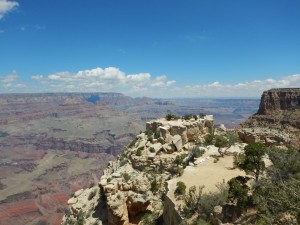 |
On this spot in 1540, Coronado’s expedition in search of the fabled “Seven Cities of Gold” became the first Europeans to lay eyes on the Grand Canyon. In need of water, they followed a Ute Indian guide to a “great river” he said was nearby. They spent three days trying to find a way down to the Colorado, without success. |
| Grandview Point was once home to the most popular tourist destination in the canyon. In the late nineteenth century, prospector Pete Berry staked a claim on a copper mine below the rim. For some years is was highly successful, producing unusually pure ore, but the difficulty of carrying ore and equipment by mule train up and down the canyon trail made it costly, and a collapse in copper prices ended the mining operation. The enterprising Berry converted his mining camp to a hotel, and the mules used to carry ore into mule rides for the tourists down the canyon. The Grandview Hotel was a success until 1901, when the Santa Fe railroad laid a line directly to Berry’s competition, the Bright Angel lodge in what is now Grand Canyon Village. After that, visitors were less willing to endure the grueling stagecoach ride to Grandview, and Berry went out of business. No trace of the hotel remains on the canyon rim today. |
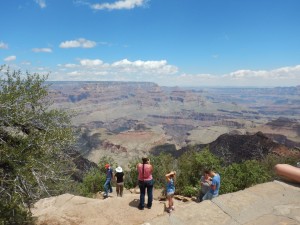 |
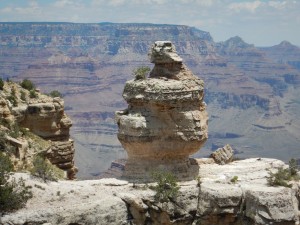
“Duck on a Rock.”
Do you see it?
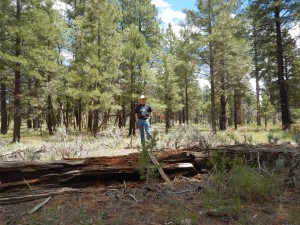 |
Driving along the rim, at one point the Pinyon & Juniper “dwarf forest” gives way to tall Ponderosa pines. As a biologist (if no longer an actively practicing one) I was curious about the reason for the change in the ecosystem— but all the information in the park centers on what’s down inside the canyon. |
| A sight visible in many national parks, majestic herds of wild paparazzi follow the elk wherever they may go. |
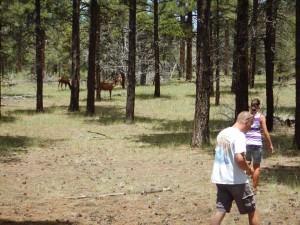 |
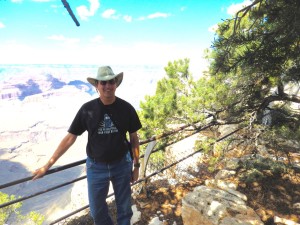 |
Doctor Who shirt? Check.
Cowboy hat? Check.
Cowboy Geek Achievement Unlocked. |
| The El Tovar hotel in Grand Canyon Village, built in 1905. |
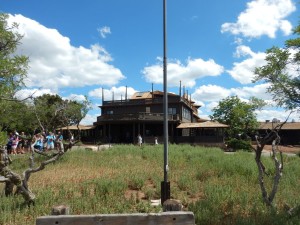 |
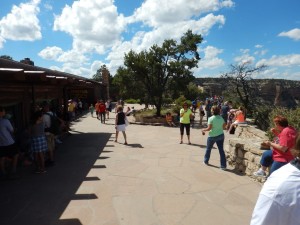 |
Crowds in the village (and lines at every shuttle bus stop) resembled Disneyland. If not for the kick-off provided by the Writers Retreat in Taos, I’d never plan a trip like this for peak tourist season. |
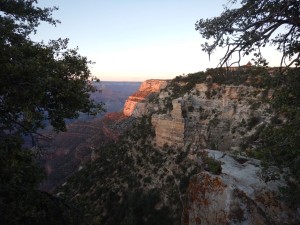
And so the sun sets on the Grand Canyon leg of my road trip.
Tomorrow: Petrified Forest
Like this:
Like Loading...
Related

